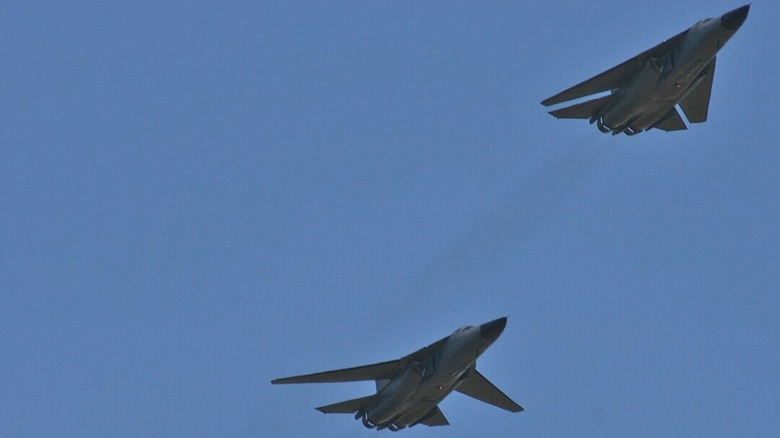Why The US Air Force Retired The F-111 Aardvark Fighter Jet
The F-111 Aardvark aircraft proved itself to be a dependable mission platform, especially in Operation Desert Storm , when its ability to fly low and fast gave it an advantage. When the United States Air Force retired the Aardvark, the military branch lost some capability, especially in terms of the long-distance high-speed, low-level precision fighter-bomber role. Moreover, the end of the electronic warfare version, the EF-111, created a significant hole that the USAF couldn't fill at all, and the U.S. Navy had to step in and cover with planes like the impressive EA-6B Prowler.
The problem with the F-111 series was that it was too expensive to maintain. By the time it was retired, the F-111 ate up a quarter of the Tactical Air Command (TAC) maintenance budget, but accounted for only nine percent of the fleet. The Royal Australian Air Force found it to be twice as expensive to maintain as the next most expensive aircraft, namely the F/A-18 Hornet. The Aardvark was always temperamental, too. Overall, the F-111 was a stable platform, but its navigation systems –despite being one of the best of its time — had some issues that led to less than 20 hours mean-time between failures, forcing crews to develop multiple redundancies.
The F-111 in operation
The F-111 wasn't perfect when it underwent trials in Vietnam in 1967. Out of 55 combat flights, three aircraft crashed due to malfunctions or accidents. After an extensive review, it commenced active duty in 1972 with the Constant Guard bombing campaign, then Linebacker II. Between October 1972 and March 1973, the F-111A flew over 4,000 combat flights with only six losses due to enemy engagement. Unlike other strike aircraft, the Aardvark rarely needed support aircraft such as tankers or air cover, and such missions became a signature of the aircraft.
The F-111 was next used in 1986 against Libya in Operation El Dorado Canyon, where technical problems significantly affected the success of the mission. Later, the F-111 was important for establishing air dominance for the Allied effort in the Persian Gulf. The F-111 flew over 5,000 missions during Gulf War I and had one of the highest availability rates. In all, the F-111 flew a million flight hours with 77 total losses.
Australia's F-111s
Even after the U.S. retired its F-111 fleet, the Royal Australian Air Force (RAAF) flew the type for another decade. The F-111, known as the Pig in Australia, had a range and bombload unmatched in the Southwest Pacific region. The Australians' wind-down of F-111 operations was accompanied by a different sort of controversy than the Americans had with the focus on budget cuts and covering capability gaps.
The need to maintain the ageing airframes was an issue, but health concerns arose regarding the airmen who worked on the F-111. The intense maintenance regime included regular desealing and resealing the fuel tanks. This process required hours spent inside the tanks to remove old sealant and apply new. Cancer rates among the maintenance crews have been the subject of several studies by the Australian government.
The Royal Australian Air Force replaced their F-111s with 24 F-18F Super Hornets. However, even the Super Hornet would never be able to replace the F-111 in what was probably its most crowd-pleasing role. An F-111 pilot could pump fuel straight through to the afterburner, then light them and produce a flame that was longer than the airplane. The "dump and burn" move was a favorite at air shows.


